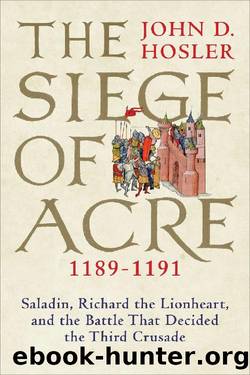The Siege of Acre, 1189-1191 by John D. Hosler

Author:John D. Hosler [Hosler, John D.]
Language: eng
Format: epub
ISBN: 9780300215502
Publisher: Yale University Press
Published: 2018-06-25T19:00:00+00:00
4. Layout of Acre.
Three other areas belonged to no one particular group but rather constituted residential and administrative sectors. The northeast area and the “rectangular” quarter were largely residential. The former contained a number of churches and, on its southern side, by the water, was the crusader arsenal. The latter quarter seems to have been a poorer, though well-defended, residential district, and, later, inside it sat a Dominican monastery.18 The Quarter of the Chain (Ruga cathene) was astride the harbor and served as a customs office; it fell under the jurisdiction of the king of Jerusalem.
Now that Acre was back in Christian hands, the burgesses of the city petitioned the kings, arguing that the properties had been theirs before Saladin had taken the city over four years previously, on 9 July 1187, and should now be returned to them. Richard and Philip agreed that they ought not to be disinherited and ordered the properties returned, albeit with the qualification that the knights could remain as lodgers until the army moved on from the city. The kings themselves took the best lodgings, Philip in the castle in the Hospitaller quarter and Richard with the Templars.19
Many of the buildings in the city were in disrepair, having been damaged by the artillery fire; but the churches were in the worst shape because their interiors had been desecrated by the Muslims, with crucifixes, altars, and statues smashed. Theobald, the titular bishop of Acre, received his episcopal chair with the recovery of the city, but he would have much work to do in restoring the condition of the facilities under his direction. Repairs began soon after Acre was retaken: while Richard concerned himself with the rebuilding of the damaged portions of the city wall and the emptying of its moat, several prelates took to restoring and re-consecrating the churches.20 Yet continuing debates over the spoils of Acre soon led to acrimony and division.
Perhaps the biggest beneficiaries of the victorious siege were the Italians, who received properties in the city, as well as significant financial allowances for their role in both overseas transport and battle.21 Many of these rights were, in fact, granted during the siege, before Acre was even in Christian hands. The Pisan commune received the most liberties, if not land, as spelled out in great detail in a confirmation grant from Guy and Sibylla in November 1189. In terms of property, the Pisans received back their quarter and those buildings in their possession in 1187, a mill, and the right to maintain their own churches. Other benefits included freedom from all tolls, a curia by which to adjudicate most of their own affairs, the right to collect fees from resident Pisans there (and a corresponding prohibition on Guy of Lusignan from doing the same), the right to garrison Pisan soldiers in the city and at its gates, and freedom from a whole host of ancillary fees on shipwrecks, ovens, baths, and so on.22 In 1191, Richard the Lionheart made them the patrons of
Download
This site does not store any files on its server. We only index and link to content provided by other sites. Please contact the content providers to delete copyright contents if any and email us, we'll remove relevant links or contents immediately.
| Africa | Americas |
| Arctic & Antarctica | Asia |
| Australia & Oceania | Europe |
| Middle East | Russia |
| United States | World |
| Ancient Civilizations | Military |
| Historical Study & Educational Resources |
The Radium Girls by Kate Moore(11921)
100 Deadly Skills by Clint Emerson(4840)
Rise and Kill First by Ronen Bergman(4704)
The Templars by Dan Jones(4628)
The Doomsday Machine by Daniel Ellsberg(4416)
The Rape of Nanking by Iris Chang(4138)
Killing England by Bill O'Reilly(3951)
Hitler in Los Angeles by Steven J. Ross(3900)
Stalin by Stephen Kotkin(3875)
12 Strong by Doug Stanton(3508)
Hitler's Monsters by Eric Kurlander(3268)
Blood and Sand by Alex Von Tunzelmann(3138)
The Code Book by Simon Singh(3074)
Darkest Hour by Anthony McCarten(3071)
The Art of War Visualized by Jessica Hagy(2944)
Hitler's Flying Saucers: A Guide to German Flying Discs of the Second World War by Stevens Henry(2715)
Babylon's Ark by Lawrence Anthony(2620)
The Second World Wars by Victor Davis Hanson(2482)
Tobruk by Peter Fitzsimons(2444)
